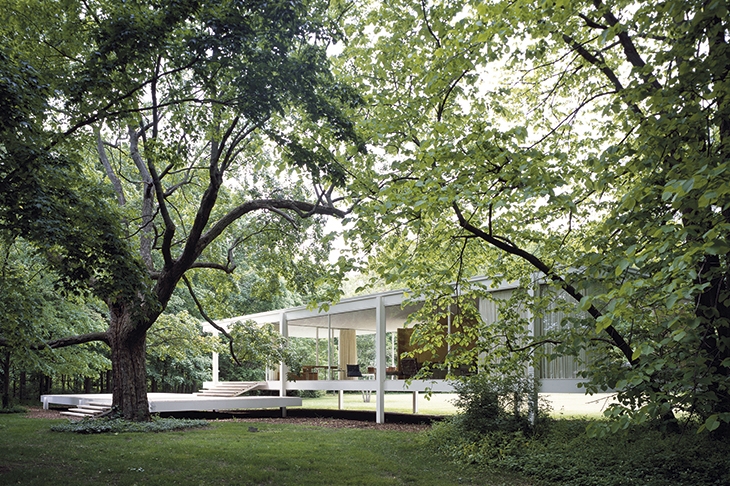John Ruskin believed the most beautiful things are also the most useless, citing lilies and peacocks. Had he known about the Farnsworth House in Plano, Illinois, a rural community 50 miles west of Chicago, he might have suggested it too. Except this modernist building of 1951 is an evolved expression of the emerging industrial culture Ruskin so despised.
But it is several other things too, notably an example of fraught transactions between architect and client. The Farnsworth test case became a trial whose transcript ran to 3,800 pages. Of all relationships, except that between a firing squad and its target, the architect-client example is the one most predictably headed for calamity. You have the cost-conscious client, the egotistical and ambitious designer and the dodgy contractors in an infernal triangle, each determined to take advantage of one or all. H.B. Creswell wrote amusingly of this in The Honeywood File in 1929, but that was Wodehousian compared with the vicious dispute between Ludwig Mies van der Rohe, the last director of the Bauhaus, and his client and sometime lover Dr Edith Farnsworth.
He: an imperious artisan stonemason-architect from Aachen, the spiritual home of the Holy Roman Empire, who grudgingly spoke English after fleeing Nazi Germany for the US — but only after failing to sell the Bauhaus idea to Hitler as quintessentially German. His name was something of an invention, adding ‘van der’ to his mother’s maiden name. This nobiliary particle was a Dutch formulation (he was anxious for some reason to avoid the German ‘von’). He was prone to mysticism: beinahe nichts, or ‘nearly nothing’, was his design mantra. So, too, was the better known weniger ist mehr, or ‘less is more’. Additionally, he was a misogynistic womanizer, a solipsistic drinker, a swanky but solemn dresser, a careless building administrator and a chain-smoker of cigars.
She: rich, headstrong, needy, articulate, no great looker, a research-grade nephrologist, a musician, and a poet and translator.
They met at a Chicago dinner party in 1945 where Mies had been monosyllabic-going-on-somnolent until, to Farnsworth’s astonishment, he volunteered himself for a vaguely proffered commission to design a weekend cottage for her. She had expected him to nominate an office junior. By 1948 they had fallen in and out of bed, but there would still be three years of recriminations before the house was finished. In this context, grievances festered. They say she wanted Mies and the house while he wanted the house and the next client.
To see the Farnsworth House in reality is to understand how perfection can be revealed in steel and glass. It is an understanding no visitor can resist. But to live in it — as I once did for several days — is to put every assumption of the modernist aesthetic to severe test.
It is an astonishingly beautiful building, as visceral as it is intellectual. The way in which elementary materials and ‘nearly nothing’ have a transcendent effect is profound. It floats, perfect proportions denying material weight. From outside it looks agreeably alien; from inside, its transparency makes landscape captive. And the architect’s attention to the logic of structure and to detail is revelatory. Rivet heads were painstakingly ground off at steel junctions to make visually perfect joints. The frame is made with such fanatical precision that it responds to impacts like a tuning fork. As a whole, the Farnsworth House improves upon nature, which was Voltaire’s definition of art.
Yet it is absurd. Mies insisted on building on the Fox River’s floodplain, the better to enjoy the local woods. He refused thermally efficient double-glazing. Only after protest was Farnsworth allowed a wardrobe; Mies said it was a weekend house and the necessary single dress could be hung out of sight behind the bathroom door. He was adamant that his own furniture designs were used rather than his client’s preferences. Moreover, his architectural training had not included Mechanical & Electrical Services, so he knew nothing of plumbing, heating, air-conditioning, drainage or power supply. Water seepage from above complemented the rising damp caused by the turbulent, intrusive Fox below. The house was an oven in summer and a freezer in winter. Ugly stains soon appeared. When Farnsworth complained about the exiguous fireplace, Mies said: ‘Get smaller logs.’
The original budget had been $10,000.But this ‘functionalist’ architect was notoriously sloppy in business, and the account came to seven times as much. Despite his managerial incompetence, Mies took Farnsworth to court over unpaid fees and won. Her revenge was to fill the house with unsuitable furniture — and eventually to go to live in Italy (where her relationship with the poet Eugenio Montale was another episode of Euro-flavored unrequited love).
Farnsworth House is a magnificent catastrophe, a manifesto of designer arrogance, a maintenance nightmare, an unlivable space where God fought with Satan over the details, especially the boiler and drains. And it is now a national monument, a pilgrimage site for architecture students from all over the world. Widely imitated (by designers whom Nikolaus Pevsner called ‘three blind Mies’), it has never been bettered. In a sense, it couldn’t be.
The suspicion must be that the client’s susceptibility was exploited to fund a consummate Meisterschaft: steel and glass cannot be taken further, while structure could not be further reduced. Nor could any relationship be more ruinously stretched. For this, any aestheticist must be grateful, while any ethicist must wince at the human and practical cost.
Alex Beam is not a specialist architectural writer, and Broken Glass benefits greatly from a broader perspective and wide reading (including Farnsworth’s unpublished journals and the extensive trial transcripts). There is no jargon, nor any special pleading. A former columnist for the Boston Globe, Beam has published on Nabokov as well as Liverpool FC, causing a fuss by describing Hillsborough as a ‘riot’ and the city itself as ‘doggy’. Still, here he writes with good-natured and witty insight. It is a compelling book — perhaps the best narrative I have ever read about modern architecture.
Read it and beinahe nichts haunts you. The more so if you have slept in this mad but heartbreakingly beautiful building. Nearly nothing, but quite something too. Broken Glass’s dedication is: ‘To Edith.’
This article was originally published in The Spectator’s UK magazine. Subscribe to the US edition here.


















